Posted: July 4th, 2016 | No Comments »
Hoggard and Sigler’s was one of Shanghai’s best antiques and curio stores. Located in the Sassoon Arcade, (part of the Cathay Hotel), the store was famous for very high quality art works and curios. The American-run company was in business from 1927 through till the war. They stocked their own sourced antiques and curios as well as representing various specialists such as Nichols Chinese Rugs from Tientsin (Tianjin), which they traded under the name Fette Peking Rugs.
The partners in the business were Clarence Doane Hoggard (who had come to China in 1919 as an auditor for the international YMCA and stayed) and W. Warren Sigler (Sigler died some time before the end of WW2). The shop was partially damaged in August 1937 with the bombing of the Cathay Hotel on Bloody Saturday. Hoggard returned to Shanghai in 1940, salvaged what he could of the stock and left Shanghai once again for America. His ship was near Borneo at the time of Pearl Harbor but eventually made it back to the USA. After the war Hoggard continued to trade Oriental antiques and curios in America – at the time of his arrival back in the USA he mentioned opened stores in both Tuscon, Arizona and St Petersburg, Florida. He did indeed open a new shop at no.9 East Penington Street in Tuscon called “Tjen” (perhaps someone in Tuscon could stroll past and see what’s there now?). Here he seems to have sold the remaining stock of antiques, statuary and curios from his Sassoon Arcade store.
While in Shanghai Hoggard and Sigler seem to have done well from the curios business, owning a nice house from 1931 in the exclusive Columbia Circle to the west of the Settlement (just off Xinhua Road now). However, they didn’t live there but rented it out to U.S. Harkson, a businessman who, among other interests, owned one of Shanghai’s first radio stations.
Items with a Hoggard-Sigler provenance still come up for auction now and then such the these below that were auctioned at Bonham’s in London quite recently and listed as having been purchased at Hoggard-Sigler around 1936.

Carved and tinted ivory model of a cabbage and insects – Republican period
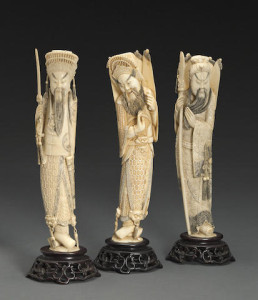 group of three carved and tinted ivory martial figure – Republican period
group of three carved and tinted ivory martial figure – Republican period
 A large carved ivory head of Guanyin – Republican period
A large carved ivory head of Guanyin – Republican period
Posted: July 2nd, 2016 | No Comments »
These days journalists (sorry media folk) just aren’t trusted much. It would be a brave advertiser that used a hack to endorse a product and expect the public to react well. Not so in the 1930s it seems. Floyd Gibbons was an amazing self-promoter and a journalist. He was a veteran reporter with the Chicago Tribune who had covered the Mexican border war of 1916, the torpedoing by the Germans of the Laconia (on which he was a passenger), the fighting at Belleau Wood in the First World War (where he lost his eye and took to wearing his trademark eye- patch) and the 1921 famine in Russia. In 1932 he headed to China to cover the fighting in Shanghai and the Japanese occupation of Manchuria. Still, he found time to endorse Goodrich Tyres. His point was that while he was watching the death and destruction in China even more people got killed and injured on America’s roads in car accidents….war correspondent with a mortgage to pay? maybe it’s time to call your agent?
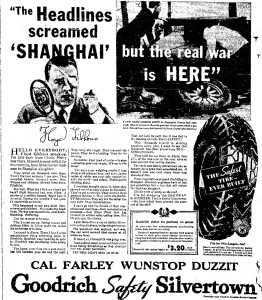
Posted: July 1st, 2016 | 1 Comment »
Excellent news that Macao’s Museum of Art is hosting an exhibition dedicated to the work of Auguste Borget (more details on times, venue etc here). For many of us it is George Chinnery who we associate with portraits of Macao, but Borget was almost as equally prolific as well as painting Hong Kong and southern China. Just as Chinnery left London and Dublin so Borget left Paris and pitched up in China, in Canton (Guangzhou) in 1838. He remained in southern China for nearly a year and did indeed know Chinnery – the two went on sketching expeditions together.

Borget went on to visit Manila, Singapore and India before returning to Paris – Chinnery of course remained a lifelong ex-pat. His best works are gathered together in his 1842 book Sketches of China and the Chinese. Borget’s work is now scattered among private collections and museums in Hong Kong, France, Hawaii (where he also stopped and painted) and Singapore. If you can get to Macao the exhibition runs till October 9 this year.
Borget’s work, like Chinnery’s, give us a pre-photographic view of Hong Kong, Macao and southern China in close detail, a quite fantastic pictorial record of the place, people and times….




Posted: June 30th, 2016 | No Comments »
Lynn Pan’s When True Love Came to China has been out for a few months, but I wanted to make sure it was available globally before mentioning (as people sometimes complain they can’t get books in various territories)….but it is now on all the usual online vendors and good bookstores (here at Amazon UK and here at Amazon US). I suppose I shouldn’t really need to recommend a new Lynn Pan book to China Rhyming regulars who I expect will be familiar with all her previous work….
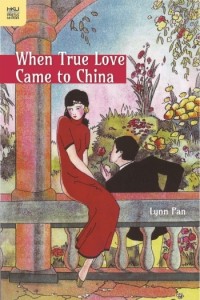
Most people suppose that the whole world knows what it is to love; that romantic love is universal, quintessentially human. Such a supposition has to be able to meet three challenges. It has to justify its underlying assumption that all cultures mean the same thing by the word ‘love’ regardless of language. It has to engage with the scholarly debate on whether or not romantic love was invented in Europe and is uniquely Western. And it must be able to explain why early twentieth-century Chinese writers claimed that they had never known true love, or love by modern Western standards. By addressing these three challenges through a literary, historical, philosophical, biographical, and above all comparative approach, this highly original work shows how love’s profile in China shifted with the rejection of arranged marriages and concubinage in favor of free individual choice, monogamy and a Western model of romantic love.
Lynn Pan was born in Shanghai and educated in London and Cambridge, England. She is the author of more than a dozen books on China and the Chinese diaspora, including Shanghai Style; Tracing It Home; and Sons of the Yellow Emperor, the winner of the Martin Luther King Memorial Prize.
‘This book, Lynn Pan’s best to date, adds a wonderful new angle by encouraging us, via comparison, to better appreciate how unusual, even in some ways exotic, a part of the Western past we take for granted, as though it were natural, actually is. While the reader will learn a great deal about Chinese literary and cultural traditions from this book, if read with an open mind the Western reader may end up rethinking things about his or her tradition just as deeply.’
—Jeffrey N. Wasserstrom, Chancellor’s Professor of History, University of California at Irvine
‘Nobody writes about China quite as brilliantly as Lynn Pan, who in this new, illuminating work on love showcases her trademark erudition entwined with a novelist’s sensibility. Pan’s rare skill makes the book a treat from start to finish; a sumptuous, deft and moving analysis of China’s relationship with love.’
—Mishi Saran, author of Chasing the Monk’s Shadow: A Journey in the Footsteps of Xuanzang and The Other Side of Light
Posted: June 29th, 2016 | No Comments »
Opening an old book the other day I found this ticket for the Peak Tram in Hong Kong circa 1930s. This one could get you from the Lower Terminus on Garden Road or the station at Kennedy Road up to Plantation Road (now the Barker Road station I think) or the Upper Terminus (now a ghastly shopping centre). You’ll note this is a first class ticket – first class was for colonial officials or residents of Victoria Peak only (second class was for military and Hong Kong Police personnel) and third class for everyone else and animals.
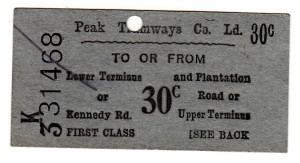
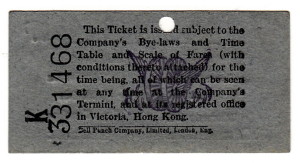
Posted: June 28th, 2016 | No Comments »
Shanghai’s Jukong Road (now Zhongxing Road) was right on the border of Hongkew (Hongkou) and Chapei (Zhabei). This meant that from 1937 it got hammered in the fighting between Chinese and Japanese soldiers. The first three pictures below show how bad it got gutted. However, some of it survived amazingly and other parts were restored and rebuilt. But what survived the war couldn’t necessarily survive Shanghai’s relentless destruction/construction boom and philistine leaders. The last of the original Jukong Road recently went under the wrecker’s ball….
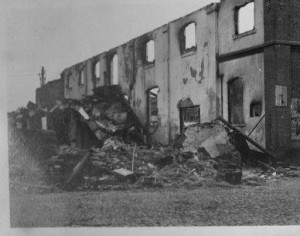
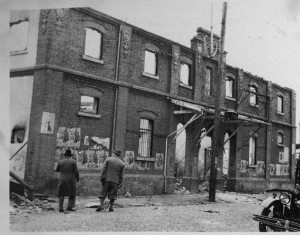
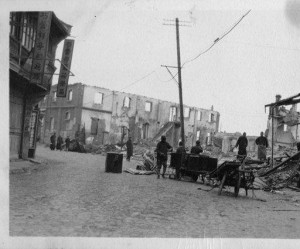
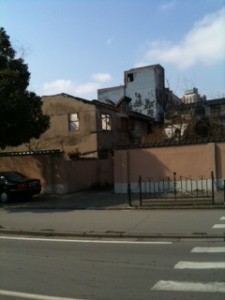
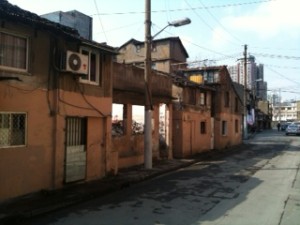

Posted: June 27th, 2016 | No Comments »
I was blogging the other week about Lotus Liu, who started out in a Shanghai acting class and got to Hollywood. Other great stars that made it from China to Hollywood – Sari Maritza of Tientsin should be noted; sadly Nina Barsamova never quite made it. Lyda Roberti though made it big in Hollywood and on Broadway after Shanghai. She’s pretty forgotten now but worth remembering…

Lyda was born in Warsaw (then part of the Russian Empire) in 1906. Her grandfather and father were both famous circus clowns; her mother was a trick pony rider. They were a circus family. Lyda, fro childhood, was a circus performer and dancer and travelled with the circus around the world. Come the Russian Revolution the family fled across Siberia and eventually settled in Shanghai – another White Russian refugee family in the city. Sadly the reformed circus went bankrupt in Shanghai but Lyda got a job dancing at the Carlton Cafe (Which was a fabulous establishment and worthy of its own blog post one day). Lyda made enough money to get a ship to America (it’s been said she wanted to escape her abusive father) and became a star of the Vaudeville circuit (including alongside Eddie Cantor) with her blonde good looks, Polish accent and dancing skills. To cut a longish story short she eventually made it into the movies. The papers loved her Shanghai past and she was happy to play it up (see below)…”…Lyda Roberti, who draws a Paramount contract, waited on tables in China when her show stranded there.”
 Lyda played a Mata-Hari type alongside WC Fields…took a lot of Mae West type roles….eloped and married the radio announcer Hugh Ernst…all the usual Hollywood shenanigans. But her health was never good, she suffered frequent heart attacks and finally succumbed to heart disease in 1938. Her mother and father remained in Shanghai and I’m not sure what became of them. Anyway, Lyda lived the dream from Shanghai to Hollywood…
Lyda played a Mata-Hari type alongside WC Fields…took a lot of Mae West type roles….eloped and married the radio announcer Hugh Ernst…all the usual Hollywood shenanigans. But her health was never good, she suffered frequent heart attacks and finally succumbed to heart disease in 1938. Her mother and father remained in Shanghai and I’m not sure what became of them. Anyway, Lyda lived the dream from Shanghai to Hollywood…



Posted: June 26th, 2016 | 5 Comments »
The Union Steamship Agency got you back to Europe from Shanghai about as cheaply as anyone could – might be a bit of a round about route though but still only 16 days. Problem was that Europe was Vladivostok!
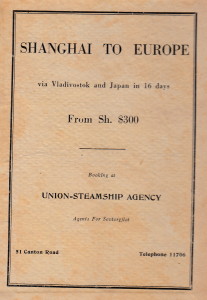
 group of three carved and tinted ivory martial figure – Republican period
group of three carved and tinted ivory martial figure – Republican period A large carved ivory head of Guanyin – Republican period
A large carved ivory head of Guanyin – Republican period




















